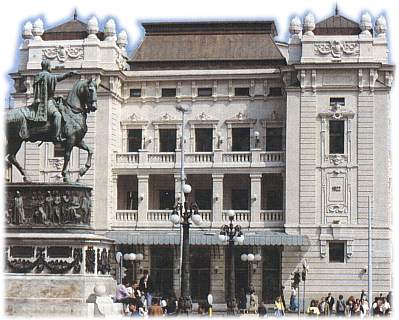 Built in 1869 to the design of Aleksandar Bugarski, the most fruitful architect
in 19th century Belgrade. The decision to construct a special building for the theatre
was taken by Mihailo Obrenović, but the foundation stone was laid and the charter drawn
up three months after his death, in the presence of Prince Milan and his regents on 18
August 1868. The theatre was formally opened on 30 October 1869 with a performance of
Posmrtna slava Mihaila Obrenovića III (The Posthumous Glory of Mihailo Obrenović III),
written for the occasion by the theatre manager, writer and politician Đorđe Maletić
(b. Jasenovo, Banat, 1816, d. Belgrade 1888). The building was typical of the theatre
buildings of the time and was particularly reminiscent of La Scala, Milan, with regard
to its Renaissance elements and the decorative finish. Later reconstructions, however,
completely changed the original appearance, the facade being redesigned by Josif Bukavac
in 1914 and the interior by Nikola Šercer in 1965. The latest reconstruction and
extension to the theatre were completed in 1989. to designs by architects Slobodan
Drinjaković, Ljubomir Zdravković and Milan Pališaški.
Built in 1869 to the design of Aleksandar Bugarski, the most fruitful architect
in 19th century Belgrade. The decision to construct a special building for the theatre
was taken by Mihailo Obrenović, but the foundation stone was laid and the charter drawn
up three months after his death, in the presence of Prince Milan and his regents on 18
August 1868. The theatre was formally opened on 30 October 1869 with a performance of
Posmrtna slava Mihaila Obrenovića III (The Posthumous Glory of Mihailo Obrenović III),
written for the occasion by the theatre manager, writer and politician Đorđe Maletić
(b. Jasenovo, Banat, 1816, d. Belgrade 1888). The building was typical of the theatre
buildings of the time and was particularly reminiscent of La Scala, Milan, with regard
to its Renaissance elements and the decorative finish. Later reconstructions, however,
completely changed the original appearance, the facade being redesigned by Josif Bukavac
in 1914 and the interior by Nikola Šercer in 1965. The latest reconstruction and
extension to the theatre were completed in 1989. to designs by architects Slobodan
Drinjaković, Ljubomir Zdravković and Milan Pališaški.
The Great Constitutional Assembly of 1888 adopted the famous new constitution of the year
in this building.


Albania Palace Building | The Bajrakli Mosque | Belgrade Palace Building | Belgrade Railway Station | Captain Miša's Building | Cvijeta Zuzorić Art Pavilion | Karađorđeva Street | Knez Mihailova Street | Princess Ljubica's Residence | Millenary Monunemt on Gardoš Hill | Price Miloš's Residence | The National Theatre | Nemanjina Street | Nikola Pašic Square | Republic Square | Skadarlija | Slavija Square | Student Square | The Trade Union Hall | Terazije Square | The '?' Cafe Restaurant | Article about the architecture and building in Belgrade |